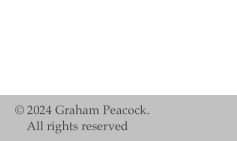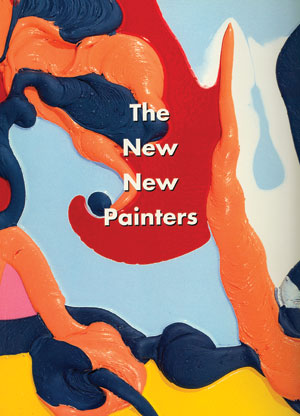|
The New New Painters
Flint Institute of Arts
Sue Scott (Guest Curator). "Graham Peacock".
The New New Painters. January 30 - April 18 (1999): page 44
Graham Peacock
(British, b. London, England 1945 -)
"My work," says Graham Peacock, "and generally that of all of the New New Painters, embraces and revels in the principle that there are no 'rules' other than the work must have a visual power and spiritual strength." Peacock knows, for he has been breaking rules almost from the time he learned them. His mature paintings are bold and aggressive, incorporating off-angle cropping, fissured and cracked surfaces, vibrant colors and a full range of unorthodox materials including florescence, glitter, glass and foam. As he sees it, his "use of new colors and materials is a means to increase my vocabulary and aid in the creation of something of lasting beauty. It is a reflection of the time in which we live."
In 1962, Peacock attended the University of London, Goldsmith's School of Art followed by graduate school at the Leeds College of Art in Yorkshire. Studying with artists such as William Tucker, Basil Beattie and Andrew Forge, his training was not only figure based but came out of a Bauhaus tradition. This fed into his appreciation of Piet Mondrian and a Minimalist sensibility and, in part, explains an overwhelming response, even as a graduate student, to Morris Louis' Unfurleds and the "Slab" paintings by Mark Rothko which he saw at the Kasmin and Waddington Galleries in London. He connected to the work being done in North America and after teaching at Newport College of Art in Wales and an extended visit to Rome, Peacock accepted a teaching position at the University of Alberta, Canada and moved to Edmonton in 1969 where he still lives and teaches today.
Peacock has always loved the expressive power of color and the artists who have influenced him range from Henri Matisse and Hans Hofmann to Jack Bush, Kenneth Noland and Morris Louis. But it was his exposure in the early seventies to the way Larry Poons threw and poured paint onto the canvas that had the greatest affect on Peacock's process. In 1980, Peacock met Kenworth Moffett and other members of the New New Painters, who encouraged him to break out of his monochromatic field paintings, inspired by Jules Olitski. He experimented with more and brighter colors and eccentric cropping as a way to solve compositional problems. This encouragement led, in 1982, to a breakthrough style in which Peacock manipulated the top layer of the painting causing it to crack and reveal the colors stacked and layered below. Termed 'crazing,' the technique has allowed Peacock to play with composition and space using the inherent properties of color and the natural movement of paint to create visual metaphors of surfaces found in nature.
Peacock begins with long lengths of canvas (some have been up to seventy feet) on which he pours the paint in layers. By controlling color relationships, thickness of the paint and the speed with which it is poured he can, to some degree, determine composition, topography of the surface and the texture of the skin of the painting. After the paint dries, Peacock makes decisions about cropping, mounting, collage, and orientation that can occupy him for months or even years
The three works in this exhibition indicate Peacock's mastery of the medium while indicating new directions in his work. The earliest, W.C.R. Pink, 1992, has a more pristine palette of pink and white suspended in clear glaze with some blue highlights. With its elongated shape, contraposto pose, figural reference and twisting colors like a barber's pole, Peacock sees in it something of "a high energy spinning figure." Rock Silver, 1996-97 and The Moon's Lair, 1996-97, are from a series of recent "glitter" paintings in which the top field colors are made from glitter pigment suspended in glaze. These two paintings have a more traditional, rectangular format than his earlier, shaped canvases. They are also more illlusionistic. The Moon's Lair, with it sphere of bright yellow paint and craggy brown surface transfers the viewer to an imaginary landscape. Rock Silver is more heraldic; perhaps an ancient shield imbued with ritualistic powers.
Peacock is intrigued with the problem of illusion, particularly as it began to break down in the twentieth century when abstraction moved toward flatness and the image became less important for replicating nature. By introducing contrasts of color, reflection, shape and light into a flat picture plane, Peacock has increased the sensation of illusionistic space from flat to shallow, and occasionally deep space. Lastly, his new work is deliberately ambiguous. Peacock looks for the intersection in abstract composition where the idea and matter coalesce; the point where the paint becomes the image yet the image remains pure paint.
|
|
|





